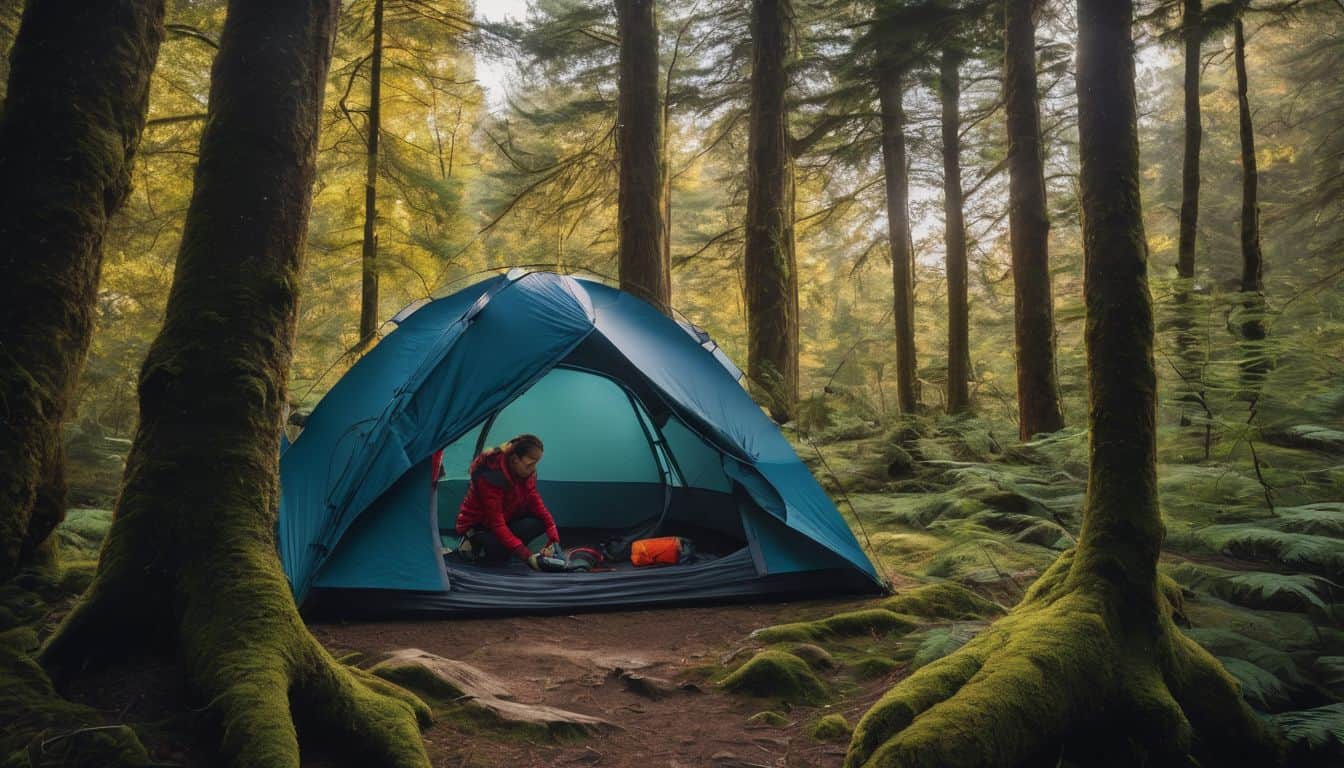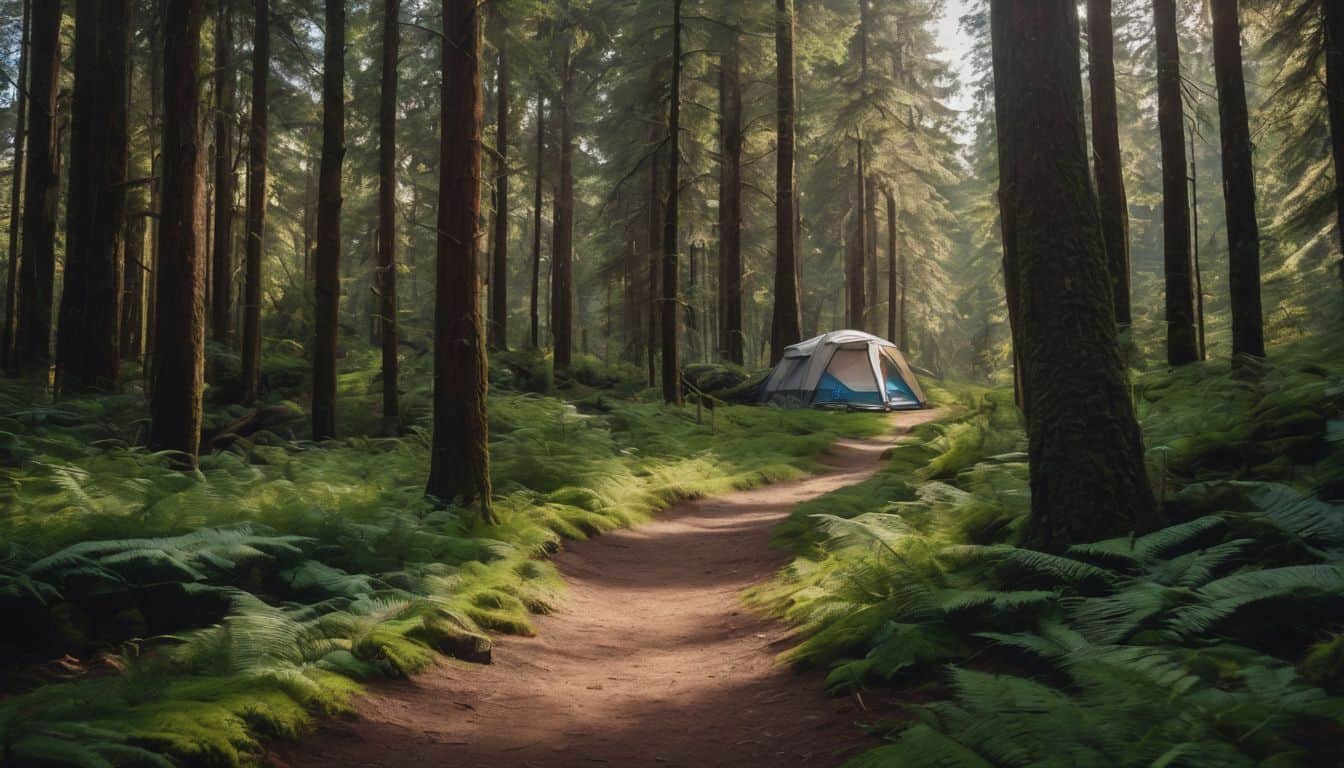Dispersed camping offers a unique opportunity to experience nature away from developed campgrounds. However, with this freedom comes the responsibility to protect the environment and respect other campers. Here’s how to practice proper etiquette while dispersed camping:
Leave No Trace
The cornerstone of dispersed camping etiquette is the Leave No Trace principle:
- Pack out all trash, including food scraps
- Use existing fire rings or camp stoves instead of creating new fire pits
- Dispose of human waste properly (bury it 6-8 inches deep, 200 feet from water sources)
- Leave natural objects and cultural artifacts undisturbed
Leave No Trace is more than just a set of rules; it’s a mindset that encourages campers to minimize their impact on the environment. This principle extends to all aspects of camping, from meal planning to site selection. By packing out all trash, including tiny scraps like fruit peels or eggshells, you prevent wildlife from becoming habituated to human food.
Using existing fire rings helps concentrate impact in already-used areas. Proper waste disposal prevents contamination of water sources and reduces the spread of disease. Leaving natural objects in place preserves the area’s beauty for future visitors and maintains the ecosystem’s balance.
Choose Your Campsite Wisely
- Camp at least 200 feet away from water sources to protect riparian areas
- Use existing campsites when possible to minimize impact
- Avoid creating new trails or expanding existing sites
- Camp on durable surfaces like rock, gravel, or dry grass
Selecting an appropriate campsite is crucial for minimizing environmental impact. The 200-foot rule for water sources helps protect these delicate ecosystems from erosion and contamination. By using existing campsites, you prevent the creation of new impact areas. This concentration of use in already-disturbed areas allows other spaces to recover and thrive.
When choosing a site, look for durable surfaces that can withstand the impact of camping without long-term damage. Avoid fragile vegetation or creating new paths, as these can lead to lasting scars on the landscape.

Respect Other Campers
- Keep noise levels down, especially after dark
- Give other campers space – don’t camp too close to occupied sites
- Be mindful of generator use – limit hours and use quiet models
- Yield to other users on trails
Respecting other campers is essential for ensuring everyone can enjoy the wilderness experience. Keeping noise levels down, particularly after dark, allows others to appreciate the natural sounds of the outdoors and get restful sleep. Maintaining adequate distance between campsites provides privacy and preserves the sense of solitude many seek in dispersed camping areas.
If you must use a generator, choose quiet models and limit use to essential times to minimize disturbance. On trails, yielding to others, especially those traveling uphill, promotes a courteous and safe environment for all users.
Practice Fire Safety
- Check local fire regulations before starting any fire
- Keep fires small and under control
- Fully extinguish fires before leaving camp or going to sleep
- Collect only dead and downed wood for fires
Fire safety is paramount in dispersed camping areas, where wildfire risk can be high and emergency services may be far away. Always check current fire regulations, as these can change rapidly based on weather conditions.
When fires are allowed, keep them small and manageable. This not only reduces the risk of the fire spreading but also minimizes the amount of firewood needed. Fully extinguishing fires is crucial – douse them with water, stir the ashes, and repeat until they’re cold to the touch. Collecting only dead and downed wood preserves living trees and maintains the area’s natural state.
Manage Water and Waste
- Bring enough water or have a reliable way to purify water from natural sources
- Use biodegradable soap for washing, and do so 200 feet away from water sources
- Dispose of grey water properly – don’t dump it directly into water sources
Proper water and waste management is crucial for protecting the environment and ensuring your own health. Bringing sufficient water or having a reliable purification method reduces the need to impact natural water sources.
When washing, use biodegradable soap and do so well away from water sources to prevent contamination. For grey water disposal, scatter it widely away from camps and water sources. This allows natural filtration through soil and prevents concentration of soap residues or food particles that could attract wildlife or contaminate water. Always think about the cumulative impact of your actions – what seems minor for one person can become significant when practiced by many campers.
Respect Wildlife
- Store food securely to avoid attracting animals
- Observe wildlife from a distance – don’t approach or feed them
- Keep pets under control and clean up after them
Respecting wildlife is crucial for both your safety and the well-being of the animals. Proper food storage, using bear canisters or hanging food bags, prevents animals from associating humans with food sources. This protects both the wildlife and your supplies. Observing animals from a distance allows them to maintain their natural behaviors and reduces stress on them.
Never feed wildlife, as this can lead to dependency and aggressive behavior. If you bring pets, keep them leashed and under control to prevent them from chasing or disturbing wildlife. Always clean up after your pets to maintain the natural environment.
For more detailed information on wildlife encounters and staying safe while dispersed camping, check out our comprehensive guide.
Be Prepared
- Research the area and obtain necessary permits before your trip
- Bring appropriate gear for the conditions
- Have a plan for emergencies and let someone know your itinerary
Being prepared is essential for a safe and enjoyable dispersed camping experience. Thorough research helps you understand the terrain, potential hazards, and specific requirements of your camping area. Obtaining necessary permits ensures you’re camping legally and supports the management of these areas.
Bringing appropriate gear, including emergency supplies, helps you handle unexpected situations. Always have a detailed plan for emergencies, including evacuation routes and nearby medical facilities. Sharing your itinerary with a trusted person ensures someone knows where to look for you if something goes wrong.
Follow Local Regulations
- Know and adhere to specific rules for the area you’re camping in
- Respect closures and restrictions
It’s crucial to understand and follow dispersed camping regulations to ensure you’re camping legally and responsibly. Regulations can vary widely between different areas and may change seasonally. These rules are designed to protect the environment, ensure fair use, and maintain the safety of all visitors. Respecting closures and restrictions, even if they inconvenience your plans, helps preserve these areas for future use and protects sensitive ecosystems or wildlife habitats.
Be Considerate with Vehicles
- Stay on designated roads and trails
- Don’t create new paths or widen existing ones
- Park in areas that won’t damage vegetation
Vehicle use in dispersed camping areas requires extra consideration. Staying on designated roads and trails prevents soil erosion and protects vegetation. Creating new paths or widening existing ones can lead to long-term damage to the landscape. When parking, choose areas with durable surfaces that won’t be damaged by your vehicle’s weight. Avoid parking on vegetation or in areas where your vehicle might leak fluids onto the soil. Remember, the impact of vehicles can be significant and long-lasting in these natural areas.
Practice Good Hygiene
- Use hand sanitizer or biodegradable soap to maintain cleanliness
- Dispose of toilet paper properly – pack it out or bury it deeply
Maintaining good hygiene while dispersed camping is important for both personal health and environmental protection. Use hand sanitizer frequently, especially before handling food. If using soap, ensure it’s biodegradable and use it at least 200 feet away from any water sources. For toilet paper, the best practice is to pack it out in a sealed bag. If burying is necessary, do so in a cathole at least 6-8 inches deep and 200 feet from water sources. Proper hygiene practices help prevent the spread of disease and minimize your impact on the local ecosystem.
Conclusion
By following these etiquette guidelines, dispersed campers can help preserve these natural areas for future enjoyment while minimizing their impact on the environment. Remember, the goal is to leave your campsite in better condition than you found it, ensuring these pristine areas remain accessible for generations to come.
If you’re planning a family trip, don’t miss our tips for dispersed camping with kids. Camping with children requires additional planning and consideration for etiquette.

Leave a Reply